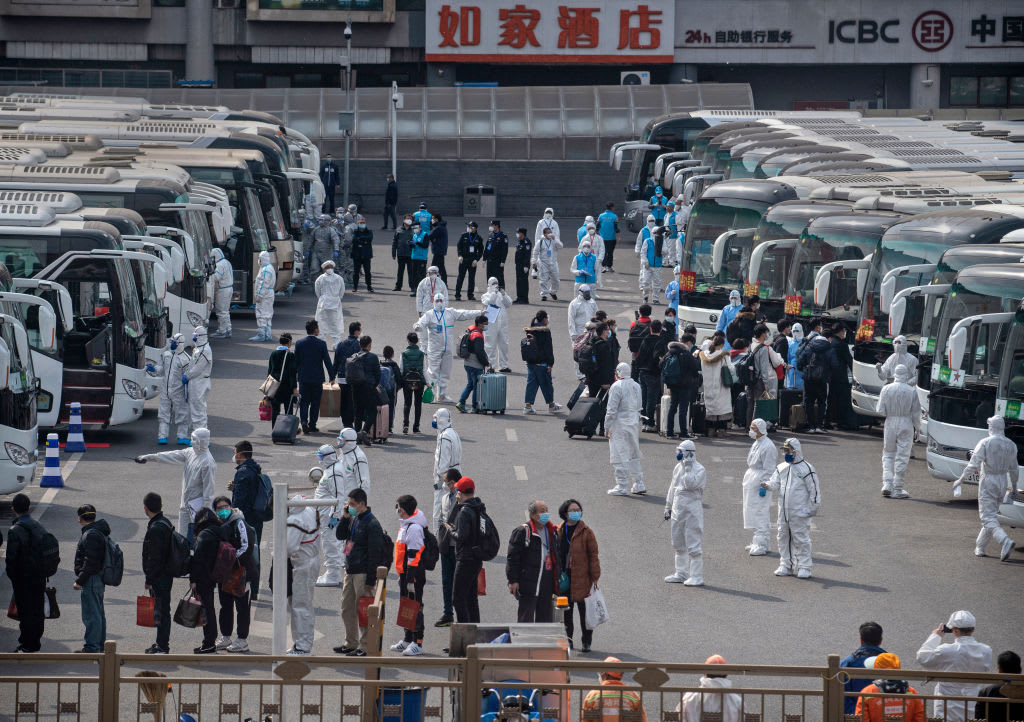
Chinese workers and health officials wear protective white suits as travelers from Wuhan gather to take buses as they are processed and taken to do 14 days of quarantine, after arriving on the first trains to Beijing on April 8, 2020 in Beijing, China.
Kevin Frayer | Getty Images
Countries run the risk of unleashing a second wave of infections of the coronavirus by lifting current restrictions on social distancing too early, according to an epidemiologist at the University of Hong Kong.
As more countries see a spike in imported Covid-19 disease cases, fears of a second wave of infection have kept various authorities on their toes while they try to determine when to ease current restrictions that have dealt a blow to all but the most essential economic activities.
“… I think having timelines is going to be very challenging. No country is going to want to open up too early, and then be the first major country to have a big second wave,” Ben Cowling, a professor at the School of Public Health at the University of Hong Kong, told CNBC’s “Street Signs Asia” on Monday.
“I think it’s going to be very difficult because we know that even countries that overcome their first wave, they’re going to have challenges from other countries who are still experiencing their first wave or even experiencing a second wave, which could be starting now in China,” Cowling added.
While the number of coronavirus cases appeared to have tapered off for countries such as China and Singapore, both have reported more cases being imported from overseas in recent days.
“It’s really going to be very difficult, I think testing is critical, but (there’s) still (a) need (for) some social distancing in place. So it may not be a full opening up, even in June or July,” Cowling said.
Worries over imported cases
“But the other lesson from Hong Kong, Singapore and elsewhere in Asia is that imported cases can really cause big problems for local epidemic control,” Cowling warned.
Singapore had garnered global praise for its early intervention in January that had successfully led to infections tapering off, before experiencing a sudden increase in the number of cases as more clusters started to emerge in recent days.
“In Singapore, they chose (test and trace) as the priority, and it seemed to work okay until there were lots and lots of imported cases that caused trouble for test and trace,” Cowling explained.
According to Cowling, the lesson from Singapore is that testing cases and tracing contacts remain important, but there needs to be “some degree of social distancing to continue in an exit strategy.”
“Otherwise there’s a danger that test and trace will work fine for a period, but then it will be overwhelmed maybe by imported cases, maybe by an outbreak,” he said.
That’s why there’s a real challenge to keep the numbers down, because after test and trace is “overwhelmed,” it would be “very, very difficult to get back on top of things as now we see in Singapore,” Cowling explained.
The challenge for the United States — which has been the hardest hit globally so far with more than 550,000 confirmed cases and with deaths exceeding 20,000, according to Johns Hopkins University data — remains how to limit the “number of importations once parts of the U.S. begin to open up again,” Cowling said.
“Because if there’s too many cases coming in, that’s going to place a big challenge for test and trace, and even for social distancing to then stay on top of,” Cowling cautioned.

